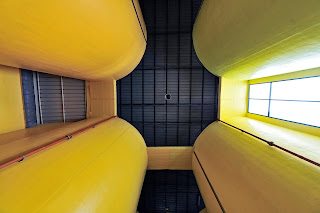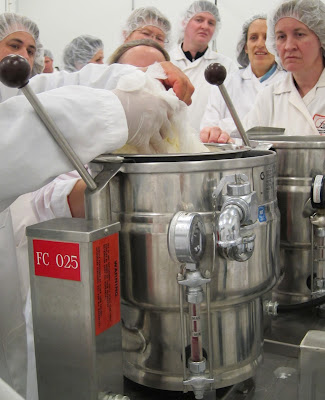Wines of Jumilla: Bodegas San Isidro
Bodegas San Isidro is the first and largest wine cooperative in Jumilla. And it’s huge. Canadian wineries are minuscule in comparison.
The cooperative, which was formed in 1934 as the Sindicato Agricola El Progreso and renamed in 1943, has 600 members. They produce 8 million bottles of wine a year as well as selling wine in bulk. There are 700 tanks holding between 20,000 and 2 million litres of wine each. There are 3000 barrels in the cellar, and even the barrels are huge!
It’s hard to imagine overseeing such a huge operation that stretches from the fields to the production and aging facilities and involves so many different players. And yet, San Isidro strives for quality just as much as the smallest artisan winery.
They proudly report that King Juan Carlos used to enjoy a bottle of their Sabatacha wine when he was serving in the Spanish navy in nearby Alicante. In fact, Sabatacha became a code word that he used to organize get-togethers with his friends (sabado – tarde – chateo, which means Saturday afternoon get-together).
One advantage of concrete tanks, which is particularly important in a hot country such as Spain, is that concrete will maintain a constant temperature.
The cellar
 Walking up the aisles, I crane my neck and am amazed by the sheer quantity of wine that is produced. But it’s not until I enter the cellar that I sense the true spirit of the winery. The air is rich with the aroma of aging wine, and the oak barrels are both familiar and exotic. I linger, marvelling at how such simple ingredients – grapes and wooden barrels – lend themselves to the complexity and variety of the wine.
Walking up the aisles, I crane my neck and am amazed by the sheer quantity of wine that is produced. But it’s not until I enter the cellar that I sense the true spirit of the winery. The air is rich with the aroma of aging wine, and the oak barrels are both familiar and exotic. I linger, marvelling at how such simple ingredients – grapes and wooden barrels – lend themselves to the complexity and variety of the wine.
The cooperative also processes olive oil, collecting both grapes and olives from its members.
The size of Bodegas San Isidro reinforced for me the importance of winemaking to the economy of Jumilla. 600 farmers and their families rely on Bodegas San Isidro for their livelihood. And there are over 40 other wineries in this region. For this community, wine is not a luxury – it’s a way of life – and they work very hard to support and maintain the industry while also respecting the grape and the wine, both of which have a life of their own. It’s not a routine office job. It requires courage, patience and passion to work in harmony with the weather, the soil, the vines, in the hopes of creating a superior wine that people around the world will enjoy.
Thank you
My thanks to Magui Gomez Gomez, Director of Enotourism, for her hospitality. Her warmth and enthusiasm are memories that I cherish.
Jumilla, Spain: 5,000 Years of Growing Grapes and Making Wine
The cooperative, which was formed in 1934 as the Sindicato Agricola El Progreso and renamed in 1943, has 600 members. They produce 8 million bottles of wine a year as well as selling wine in bulk. There are 700 tanks holding between 20,000 and 2 million litres of wine each. There are 3000 barrels in the cellar, and even the barrels are huge!
It’s hard to imagine overseeing such a huge operation that stretches from the fields to the production and aging facilities and involves so many different players. And yet, San Isidro strives for quality just as much as the smallest artisan winery.
They proudly report that King Juan Carlos used to enjoy a bottle of their Sabatacha wine when he was serving in the Spanish navy in nearby Alicante. In fact, Sabatacha became a code word that he used to organize get-togethers with his friends (sabado – tarde – chateo, which means Saturday afternoon get-together).
Quality is the underlying principle guiding all the winery’s activities.
The cooperative has a team of inspectors who visit each of the farms and evaluate the site and the vines. The inspectors determine the harvest date, and it is the bodega which groups together grapes of similar quality and characteristics.
The very best grapes are reserved for San Isidro’s premier label – Gemini (original name of Jumilla). The Gemini grapes are sorted and processed separately from all the other grapes. There is even a separate Gemini cellar.
Concrete
BSI uses a great many concrete storage tanks, as do many other Spanish wineries. It’s interesting to note that some North American wineries are now introducing concrete tanks after relying for many years on stainless steel tanks. One advantage of concrete tanks, which is particularly important in a hot country such as Spain, is that concrete will maintain a constant temperature.
The cellar
 Walking up the aisles, I crane my neck and am amazed by the sheer quantity of wine that is produced. But it’s not until I enter the cellar that I sense the true spirit of the winery. The air is rich with the aroma of aging wine, and the oak barrels are both familiar and exotic. I linger, marvelling at how such simple ingredients – grapes and wooden barrels – lend themselves to the complexity and variety of the wine.
Walking up the aisles, I crane my neck and am amazed by the sheer quantity of wine that is produced. But it’s not until I enter the cellar that I sense the true spirit of the winery. The air is rich with the aroma of aging wine, and the oak barrels are both familiar and exotic. I linger, marvelling at how such simple ingredients – grapes and wooden barrels – lend themselves to the complexity and variety of the wine.Products
Bodegas San Isidro exports approximately 40% of its wine although that percentage is increasing due to Spain’s economic crisis. The winery has a line of organic Sabatacha wines, which are sold primarily in France and Germany. Lacrima Christi is a sweet dessert wine of Monastrell grapes that has been aged for 10 years in (enormous) oak barrels.The cooperative also processes olive oil, collecting both grapes and olives from its members.
The size of Bodegas San Isidro reinforced for me the importance of winemaking to the economy of Jumilla. 600 farmers and their families rely on Bodegas San Isidro for their livelihood. And there are over 40 other wineries in this region. For this community, wine is not a luxury – it’s a way of life – and they work very hard to support and maintain the industry while also respecting the grape and the wine, both of which have a life of their own. It’s not a routine office job. It requires courage, patience and passion to work in harmony with the weather, the soil, the vines, in the hopes of creating a superior wine that people around the world will enjoy.
Thank you
My thanks to Magui Gomez Gomez, Director of Enotourism, for her hospitality. Her warmth and enthusiasm are memories that I cherish.
Jumilla, Spain: 5,000 Years of Growing Grapes and Making Wine







Comments